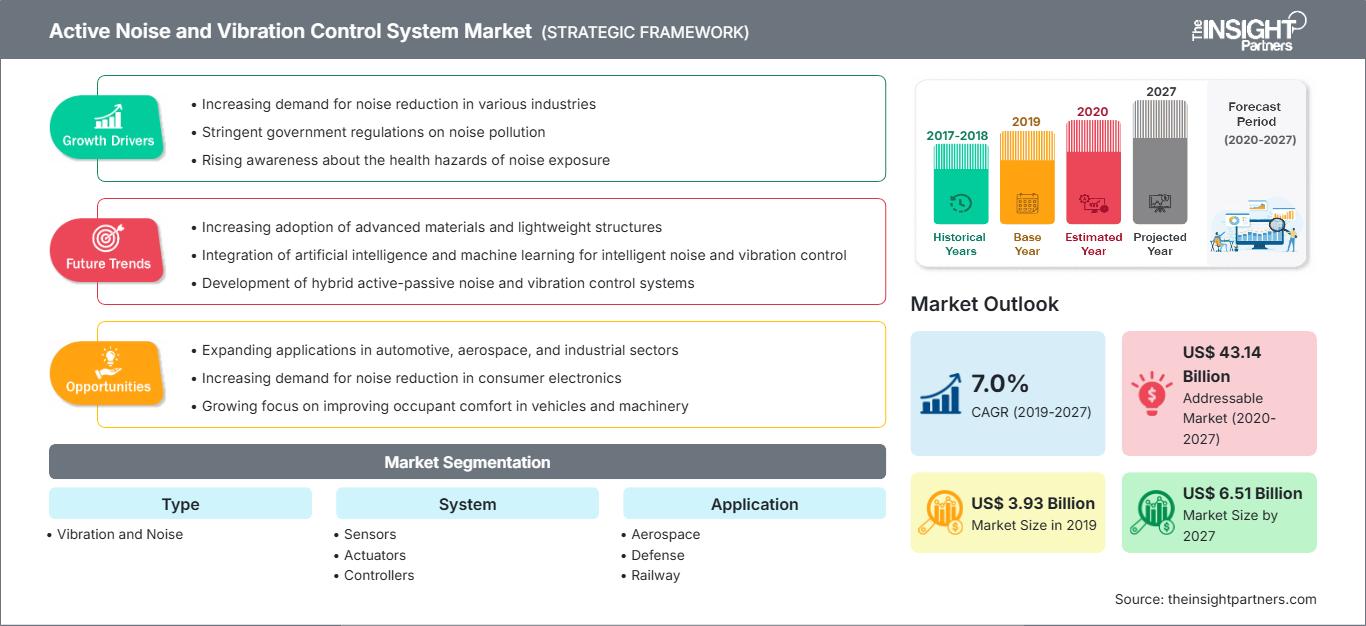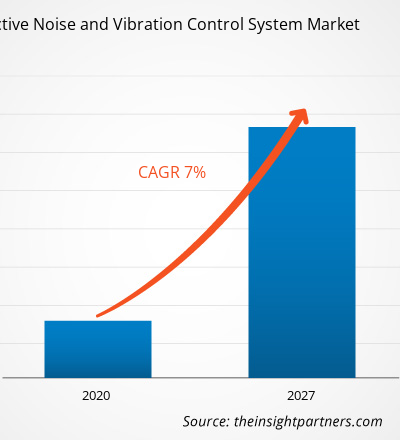En termes de chiffre d'affaires, le marché mondial des systèmes de contrôle actif du bruit et des vibrations était évalué à 3 925,61 millions de dollars américains en 2019 et devrait atteindre 6 505,28 millions de dollars américains d'ici 2027 ; il devrait croître à un TCAC de 7,0 % au cours de la période de prévision de 2020 à 2027.
Le marché des systèmes de contrôle actif du bruit et des vibrations est largement segmenté en cinq grandes régions : l'Amérique du Nord, l'Europe, l'APAC, le MEA et SAM. L'industrie aérospatiale et de la défense en Amérique du Nord est mature grâce à l'existence d'un grand nombre de constructeurs aéronautiques et au soutien continu du Département de la Défense américain. La demande de technologies de pointe est énorme dans la région, tous les utilisateurs finaux mentionnés ci-dessus étant bien informés des nouvelles technologies. Le Département de la Défense américain investit continuellement du temps et des sommes dans le développement de la flotte existante et le développement de véhicules blindés terrestres robustes ainsi que de navires, dans le but de maintenir une force opérationnelle. La présence d’un grand nombre de fabricants de systèmes de contrôle actif du bruit et des vibrations dans la région soutient la demande toujours croissante, ce qui stimule ainsi le marché des systèmes de contrôle actif du bruit et des vibrations.
Personnalisez ce rapport en fonction de vos besoins
Vous bénéficierez d’une personnalisation sur n’importe quel rapport - gratuitement - y compris des parties de ce rapport, ou une analyse au niveau du pays, un pack de données Excel, ainsi que de profiter d’offres exceptionnelles et de réductions pour les start-ups et les universités
Marché des systèmes de contrôle actif du bruit et des vibrations: Perspectives stratégiques

- Obtenez les principales tendances clés du marché de ce rapport.Cet échantillon GRATUIT comprendra une analyse de données, allant des tendances du marché aux estimations et prévisions.
Aperçu du marché – Marché des systèmes de contrôle actif du bruit et des vibrations : adoption croissante des systèmes actifs dans la fabrication ferroviaire
Vous bénéficierez d’une personnalisation sur n’importe quel rapport - gratuitement - y compris des parties de ce rapport, ou une analyse au niveau du pays, un pack de données Excel, ainsi que de profiter d’offres exceptionnelles et de réductions pour les start-ups et les universités
Marché des systèmes de contrôle actif du bruit et des vibrations: Perspectives stratégiques

- Obtenez les principales tendances clés du marché de ce rapport.Cet échantillon GRATUIT comprendra une analyse de données, allant des tendances du marché aux estimations et prévisions.
L'industrie ferroviaire mondiale connaît une croissance considérable au fil des ans, avec plusieurs avancées technologiques continues pour des voyages plus sûrs et plus confortables. Les équipements ferroviaires (bogies et chariots de chargement) subissent d'importantes vibrations verticales et un bruit important, ce qui augmente plusieurs types de risques lors de l'exploitation. Pour supprimer ces vibrations et ce bruit, plusieurs fabricants d'équipements ferroviaires se concentrent de plus en plus sur l'adoption de systèmes de contrôle du bruit et des vibrations. Le contrôle passif du bruit et des vibrations est répandu chez les fabricants ferroviaires, car ces systèmes leur permettent d'offrir à leurs clients des produits plus sûrs et plus confortables. Cependant, la majorité des systèmes passifs sont des systèmes hydrauliques, et ces dernières années, les fabricants d'équipements ferroviaires mettent l'accent sur les systèmes à commande électronique/électrique, ce qui reflète l'intérêt croissant pour les systèmes actifs de contrôle du bruit et des vibrations. Un système actif avec des actionneurs à masse inertielle montés sur les bogies peut contrôler le bruit et les vibrations basse fréquence à l'intérieur des compartiments. De plus, les systèmes actifs sont généralement des systèmes électromécaniques, qui deviennent la préférence principale des fabricants d'équipements ferroviaires. Ce facteur devrait générer une demande nettement plus élevée pour ces systèmes, catalysant ainsi le marché des systèmes actifs de contrôle du bruit et des vibrations.
Informations sur les segments de type
Selon le type, le segment des vibrations a dominé le marché mondial des systèmes actifs de contrôle du bruit et des vibrations en 2019. Les systèmes actifs de contrôle des vibrations sont des systèmes d'isolation qui réagissent dynamiquement aux vibrations externes. Ces systèmes sont utilisés pour réduire les frottements et contrôler les vibrations des machines mobiles ou statiques.
Informations sur les segments de système
Selon le système, le segment des actionneurs a dominé le marché mondial des systèmes actifs de contrôle du bruit et des vibrations en 2019. Les actionneurs sont intégrés aux systèmes actifs de contrôle du bruit et des vibrations pour contrôler diverses forces à l'intérieur de l'installation et améliorer le fonctionnement global. Ces actionneurs utilisent différentes technologies telles que la piézoélectrique, l'électrodynamique et l'électrodynamique hydraulique.
Aperçu du secteur industriel
Sur la base de l'industrie, le segment aérospatial a dominé le marché mondial des systèmes de contrôle actif du bruit et des vibrations en 2019. L'industrie aérospatiale prospère à un rythme exponentiel au fil des ans avec un grand nombre de productions et de livraisons. Français Les constructeurs aéronautiques et les fabricants de composants subissent des pressions importantes de la part des utilisateurs finaux du secteur de l'aviation commerciale pour livrer un plus grand nombre d'avions.
Les acteurs du marché se concentrent sur les innovations et les développements de nouveaux produits en intégrant des technologies et des fonctionnalités avancées dans leurs produits pour concurrencer la concurrence.
- En 2019, Creo Dynamics a annoncé son acquisition d'une participation majoritaire par Faurecia, afin de combiner la compétence de l'entreprise en matière de contrôle actif du bruit et d'acoustique automobile avec Faurecia et de développer de nouvelles solutions uniques pour le marché.
- En 2019, Terma a annoncé avoir signé un contrat avec l'UASF pour la fourniture de systèmes audio 3D pour les avions A-10.
- En 2018, Vicoda GmbH a annoncé avoir livré des amortisseurs de masse accordés pour les passerelles de Gand afin de contrôler et de réduire les vibrations induites par les piétons et de répondre aux exigences de confort en empêchant le « verrouillage » effet.
Le marché mondial des systèmes de contrôle actif du bruit et des vibrations a été segmenté comme suit :
Marché des systèmes de contrôle actif du bruit et des vibrations
Les tendances et facteurs régionaux influençant le marché des systèmes de contrôle actif du bruit et des vibrations tout au long de la période de prévision ont été analysés en détail par les analystes de The Insight Partners. Cette section aborde également les segments de marché et la répartition géographique des systèmes de contrôle actif du bruit et des vibrations en Amérique du Nord, en Europe, en Asie-Pacifique, au Moyen-Orient et en Afrique, ainsi qu'en Amérique du Sud et en Amérique centrale.Portée du rapport sur le marché des systèmes de contrôle actif du bruit et des vibrations
| Attribut de rapport | Détails |
|---|---|
| Taille du marché en 2019 | US$ 3.93 Billion |
| Taille du marché par 2027 | US$ 6.51 Billion |
| TCAC mondial (2019 - 2027) | 7.0% |
| Données historiques | 2017-2018 |
| Période de prévision | 2020-2027 |
| Segments couverts |
By Type
|
| Régions et pays couverts | Amérique du Nord
|
| Leaders du marché et profils d'entreprises clés |
|
Densité des acteurs du marché des systèmes de contrôle actif du bruit et des vibrations : comprendre son impact sur la dynamique des entreprises
Le marché des systèmes actifs de contrôle du bruit et des vibrations connaît une croissance rapide, portée par une demande croissante des utilisateurs finaux, due à des facteurs tels que l'évolution des préférences des consommateurs, les avancées technologiques et une meilleure connaissance des avantages du produit. Face à cette demande croissante, les entreprises élargissent leur offre, innovent pour répondre aux besoins des consommateurs et capitalisent sur les nouvelles tendances, ce qui alimente la croissance du marché.
- Obtenez le Marché des systèmes de contrôle actif du bruit et des vibrations Aperçu des principaux acteurs clés
- Vibration
- Bruit
Marché des systèmes de contrôle actif du bruit et des vibrations – Par système
- Capteurs
- Actionneurs
- Contrôleurs
- Amortisseurs
Marché des systèmes de contrôle actif du bruit et des vibrations – Par système
- Aérospatiale
- Voilure fixe
- Voilure tournante
- Défense
- Véhicule terrestre
- Navires de guerre
- Chemin de fer
- Industries générales
- Fabrication
- Énergie et électricité
Marché des systèmes de contrôle actif du bruit et des vibrations – Par système Par système
- Capteurs
- Actionneurs
- Contrôleurs
- Amortisseurs
Marché des systèmes de contrôle actif du bruit et des vibrations - Par région
- Amérique du Nord
- États-Unis
- Canada
- Mexique
- Europe
- France
- Allemagne
- Italie
- Royaume-Uni
- Russie
- Reste de l'Europe
- Asie-Pacifique (APAC)
- Chine
- Inde
- Corée du Sud
- Japon
- Australie
- Reste de l'APAC
- Moyen-Orient et Afrique (MEA)
- Afrique du Sud
- Arabie saoudite Arabie
- ÉAU
- Reste de la MEA
- Amérique du Sud (SAM)
- Brésil
- Reste de la SAM
Marché des systèmes de contrôle actif du bruit et des vibrations - Profils d'entreprises
- FABREEKA
- Honeywell International Inc.
- HUTCHINSON
- Terma A/S
- Moog Inc.
- Parker Hannifin
- Faurecia Creo AB
- Supashock
- Trelleborg AB
- VICODA GmbH
- Analyse historique (2 ans), année de base, prévision (7 ans) avec TCAC
- Analyse PEST et SWOT
- Taille du marché Valeur / Volume - Mondial, Régional, Pays
- Industrie et paysage concurrentiel
- Ensemble de données Excel
Rapports récents
Témoignages
Raison d'acheter
- Prise de décision éclairée
- Compréhension de la dynamique du marché
- Analyse concurrentielle
- Connaissances clients
- Prévisions de marché
- Atténuation des risques
- Planification stratégique
- Justification des investissements
- Identification des marchés émergents
- Amélioration des stratégies marketing
- Amélioration de l'efficacité opérationnelle
- Alignement sur les tendances réglementaires






















 Obtenez un échantillon gratuit pour - Marché des systèmes de contrôle actif du bruit et des vibrations
Obtenez un échantillon gratuit pour - Marché des systèmes de contrôle actif du bruit et des vibrations